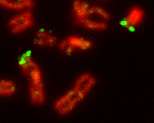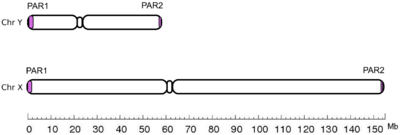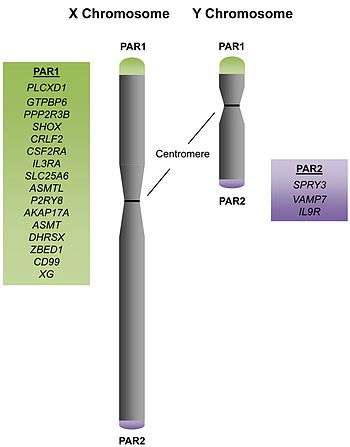Pseudoautosomal region
The pseudoautosomal regions, PAR1, PAR2,[1] are homologous sequences of nucleotides on the X and Y chromosomes.

The pseudoautosomal regions get their name because any genes within them (so far at least 29 have been found)[2] are inherited just like any autosomal genes. PAR1 comprises 2.6 Mbp of the short-arm tips of both X and Y chromosomes in humans and great apes (X and Y are 155 Mbp and 59 Mbp in total). PAR2 is at the tips of the long arms, spanning 320 kbp.[3]
Location

The locations of the PARs within GRCh38 are:[4]
| Name | Chromosome | Basepair start | Basepair stop | Band[5] |
|---|---|---|---|---|
| PAR1 | X | 10,001 | 2,781,479 | Xp22 |
| Y | 10,001 | 2,781,479 | Yp11 | |
| PAR2 | X | 155,701,383 | 156,030,895 | Xq28 |
| Y | 56,887,903 | 57,217,415 | Yq12 |
The locations of the PARs within GRCh37 are:
| Name | Chromosome | Basepair start | Basepair stop |
|---|---|---|---|
| PAR1 | X | 60,001 | 2,699,520 |
| Y | 10,001 | 2,649,520 | |
| PAR2 | X | 154,931,044 | 155,260,560 |
| Y | 59,034,050 | 59,363,566 |
Inheritance and function
Normal male mammals have two copies of these genes: one in the pseudoautosomal region of their Y chromosome, the other in the corresponding portion of their X chromosome. Normal females also possess two copies of pseudoautosomal genes, as each of their two X chromosomes contains a pseudoautosomal region. Crossing over between the X and Y chromosomes is normally restricted to the pseudoautosomal regions; thus, pseudoautosomal genes exhibit an autosomal, rather than sex-linked, pattern of inheritance. So, females can inherit an allele originally present on the Y chromosome of their father.
The function of these pseudoautosomal regions is that they allow the X and Y chromosomes to pair and properly segregate during meiosis in males.[6]
Genes
Pseudoautosomal genes are found in two different locations: PAR1 and PAR2. These are believed to have evolved independently.[8]
PAR1
- pseudoautosomal PAR1[9]
Pathology
Pairing (synapsis) of the X and Y chromosomes and crossing over (recombination) between their pseudoautosomal regions appear to be necessary for the normal progression of male meiosis.[13] Thus, those cells in which X-Y recombination does not occur will fail to complete meiosis. Structural and/or genetic dissimilarity (due to hybridization or mutation) between the pseudoautosomal regions of the X and Y chromosomes can disrupt pairing and recombination, and consequently cause male infertility.
The SHOX gene in the PAR1 region is the gene most commonly associated with and well understood with regards to disorders in humans,[14] but all pseudoautosomal genes escape X-inactivation and are therefore candidates for having gene dosage effects in sex chromosome aneuploidy conditions (45,X, 47,XXX, 47,XXY, 47,XYY, etc.).
Deletions have also been associated with Léri-Weill dyschondrosteosis[15] and Madelung's deformity.
References
- Mangs, Helena; Morris BJ (2007). "The Human Pseudoautosomal Region (PAR): Origin, Function and Future". Current Genomics. 8 (2): 129–136. doi:10.2174/138920207780368141. PMC 2435358. PMID 18660847.
- Blaschke RJ, Rappold G (2006). "The pseudoautosomal regions, SHOX and disease". Curr Opin Genet Dev. 16 (3): 233–9. doi:10.1016/j.gde.2006.04.004. PMID 16650979.
- Helena Mangs A, Morris BJ (April 2007). "The Human Pseudoautosomal Region (PAR): Origin, Function and Future". Curr. Genomics. 8 (2): 129–36. doi:10.2174/138920207780368141. PMC 2435358. PMID 18660847.
- Genome Reference Consortium (2017-01-06). "Human genome overview GRCh38.p10". Retrieved 2017-05-10.
- "Pseudoautosomal regions Gene Family". HUGO Gene Nomenclature Committee. Retrieved 2017-05-11.
- Ciccodicola A, D'Esposito M, Esposito T, et al. (February 2000). "Differentially regulated and evolved genes in the fully sequenced Xq/Yq pseudoautosomal region". Hum. Mol. Genet. 9 (3): 395–401. doi:10.1093/hmg/9.3.395. PMID 10655549.
- Weng S, Stoner SA, Zhang DE (2016). "Sex chromosome loss and the pseudoautosomal region genes in hematological malignancies". Oncotarget. 7 (44): 72356–72372. doi:10.18632/oncotarget.12050. PMC 5342167. PMID 27655702.
- Charchar FJ, Svartman M, El-Mogharbel N, et al. (February 2003). "Complex events in the evolution of the human pseudoautosomal region 2 (PAR2)". Genome Res. 13 (2): 281–6. doi:10.1101/gr.390503. PMC 420362. PMID 12566406.
- "Pseudoautosomal region 1 (PAR1) Gene Family". HUGO Gene Nomenclature Committee. Retrieved 2017-05-12.
- Levy MA, Fernandes AD, Tremblay DC, Seah C, Bérubé NG (2008). "The SWI/SNF protein ATRX co-regulates pseudoautosomal genes that have translocated to autosomes in the mouse genome". BMC Genomics. 9: 468. doi:10.1186/1471-2164-9-468. PMC 2577121. PMID 18842153.
- "Pseudoautosomal region 2 (PAR2) Gene group". HUGO Gene Nomenclature Committee. Retrieved 2019-08-30.
- "WASH6P". HUGO Gene Nomenclature Committee. Retrieved 2019-08-30.
- Eichner, E.M. (February 1991). "The mouse Y* chromosome involves a complex rearrangement including interstitial positioning of the Y-pseudoautosomal region". Cytogenetics and Cell Genetics. 57 (4): 221–230. doi:10.1159/000133152. PMID 1743079.
- Blaschke RJ, Rappold G (June 2006). "The pseudoautosomal regions, SHOX and disease". Curr. Opin. Genet. Dev. 16 (3): 233–9. doi:10.1016/j.gde.2006.04.004. PMID 16650979.
- Benito-Sanz S, Thomas NS, Huber C, et al. (October 2005). "A novel class of Pseudoautosomal region 1 deletions downstream of SHOX is associated with Leri-Weill dyschondrosteosis". Am. J. Hum. Genet. 77 (4): 533–44. doi:10.1086/449313. PMC 1275603. PMID 16175500.
